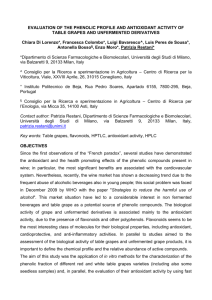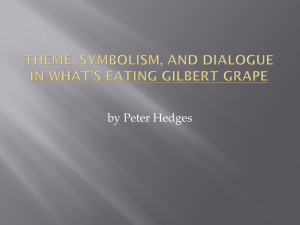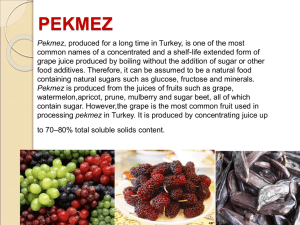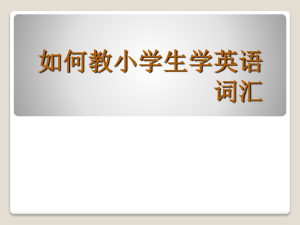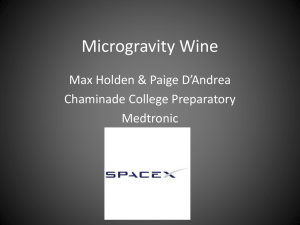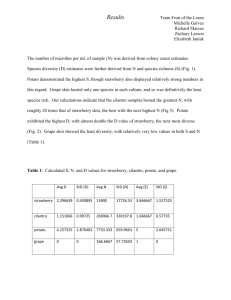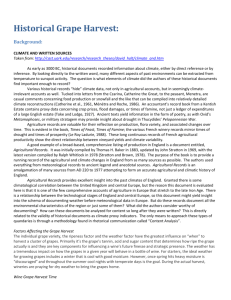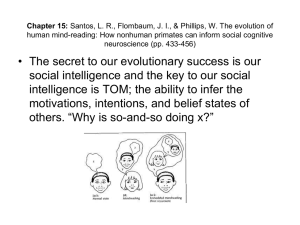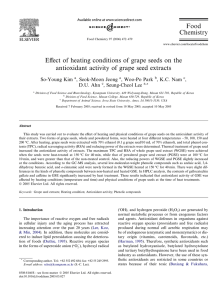SUPPLEMENTARY MATERIAL Antioxidant capacity
advertisement
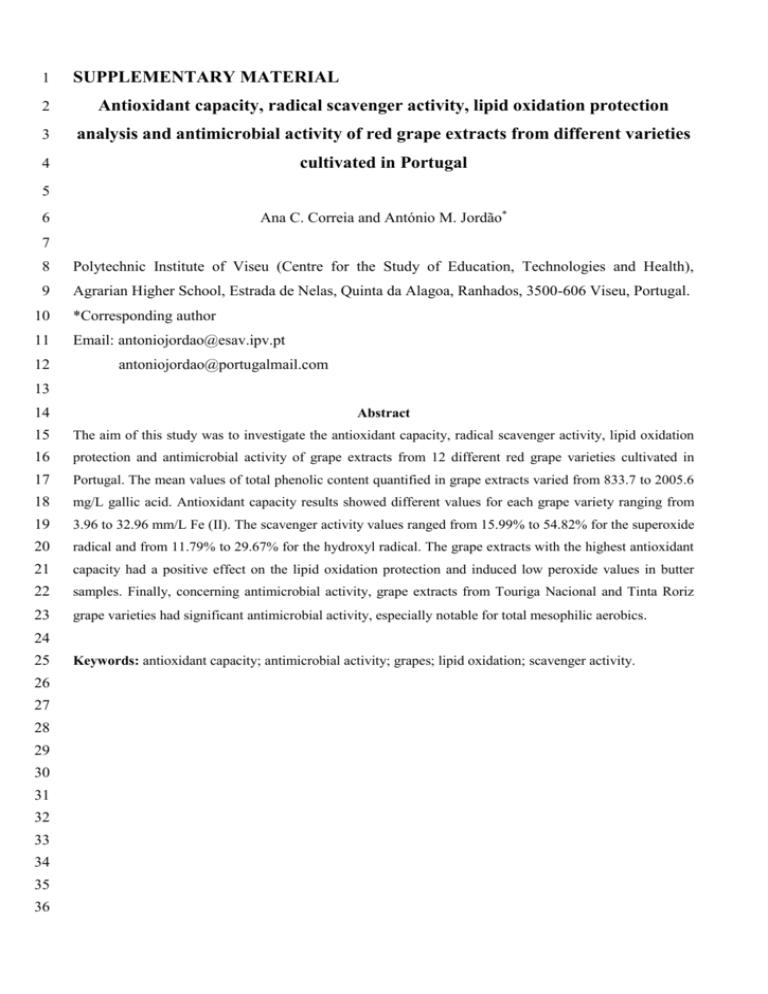
1 SUPPLEMENTARY MATERIAL 2 Antioxidant capacity, radical scavenger activity, lipid oxidation protection 3 analysis and antimicrobial activity of red grape extracts from different varieties 4 cultivated in Portugal 5 Ana C. Correia and António M. Jordão* 6 7 8 Polytechnic Institute of Viseu (Centre for the Study of Education, Technologies and Health), 9 Agrarian Higher School, Estrada de Nelas, Quinta da Alagoa, Ranhados, 3500-606 Viseu, Portugal. 10 *Corresponding author 11 Email: antoniojordao@esav.ipv.pt 12 antoniojordao@portugalmail.com 13 14 Abstract 15 The aim of this study was to investigate the antioxidant capacity, radical scavenger activity, lipid oxidation 16 protection and antimicrobial activity of grape extracts from 12 different red grape varieties cultivated in 17 Portugal. The mean values of total phenolic content quantified in grape extracts varied from 833.7 to 2005.6 18 mg/L gallic acid. Antioxidant capacity results showed different values for each grape variety ranging from 19 3.96 to 32.96 mm/L Fe (II). The scavenger activity values ranged from 15.99% to 54.82% for the superoxide 20 radical and from 11.79% to 29.67% for the hydroxyl radical. The grape extracts with the highest antioxidant 21 capacity had a positive effect on the lipid oxidation protection and induced low peroxide values in butter 22 samples. Finally, concerning antimicrobial activity, grape extracts from Touriga Nacional and Tinta Roriz 23 grape varieties had significant antimicrobial activity, especially notable for total mesophilic aerobics. 24 25 26 27 28 29 30 31 32 33 34 35 36 Keywords: antioxidant capacity; antimicrobial activity; grapes; lipid oxidation; scavenger activity. 37 Experimental 38 Sample preparation 39 Twelve Portuguese red grape varieties belonging to the Vitis specie (subsp. vinifera) were harvested at 40 technological maturity in 2011 vintage, from an experimental vineyard in the northeast of Portugal. The red 41 grape varieties studied are from vines with the following standard name and voucher specimen number (in 42 brackets): Mourisco Tinto (FRA 139), Touriga Franca (24 JBP), Touriga Nacional (19 ISA), Syrah (INRA- 43 ENTAV 470), Pinot Noir (INRA-ENTAV 872), Tinta Roriz (110 JBP), Castelão (29 EAN), Merlot 44 (ERSAFVG 353), Cabernet Sauvignon (INRA-ENTAV 169) and Alicant Boushet (INRA-ENTAV 803). 45 Baga and Touriga Fêmea red grape varieties, until now don’t have a voucher specimen number attributed. 46 Grapes (samples of 200 berries in duplicate) were kept frozen at -20 ºC until processing. For the grape 47 varieties studied, sampling was done at technological maturity and in good sanitary conditions. 48 Each grape berry sample was prepared as described by Carbonneau & Champagnol (1993). Thus, all 49 analyses were done on the extract obtained from a maceration of crushed grapes at 25 ºC for 24 h in a pH 3.7 50 buffer. All measurements were performed in duplicate. 51 Total phenolic content 52 Total phenolic compounds were determined by measuring absorbance at 280 nm using the methodology 53 described by Singleton & Rossi (1965). 54 Antioxidant capacity 55 The FRAP method was used to measure the reductive power of a sample, according to the method described 56 by Rivero-Pérez et al. (2008). It is based on increased absorbance at 593 nm due to the formation of 57 tripyridyl-s-triazine complexes with iron (II) (TPTZ-Fe(II)) in the presence of a reductive agent. The reactive 58 mixture was prepared by mixing 25 mL of sodium acetate buffer solution (0.3 mol/L, pH 3.6), 2.5 mL TPTZ 59 (10 mmol/L), 2.5 mL FeCl3 (20 mmol/L) and 3 mL water. An aliquot of 30 μL of the diluted grape extract 60 sample (diluted in water at 1:50) was added to 970 μL of the latter reactive mixture and incubated at 37 ºC 61 for 30 min. The results were expressed as mmol/L of Fe(II), using the linear calibration obtained with 62 different concentrations of FeSO4 (0.0 to 1.2 mmol/L). 63 Radical scavenger activity 64 Hydroxyl radical-scavenging activity (HRSA): Fenton reaction was used for measuring HRSA (Halliwell et 65 al. 1987). The hydroxyl radicals (HO•) were generated through the following system: 10 L of FeCl3 (0.1 66 mmol/L), 10 L of ascorbic acid (0.1 mmol/L), 10 L of H2O2 (1 mmol/L), and 10 L of EDTA (0.1 67 mmol/L). Samples (15 L at a dilution of 1:50 in distilled water) were incubated at 37 ºC for 1h, with 20 L 68 of desoxyribose (1 mmol/L final concentration) and 980 µL of potassium phosphate buffer solution (pH 7.4) 69 in the presence of FeCl3, ascorbic acid, H2O2, and EDTA. 1.5 mL of trichloroacetic acid (28 %, w/v) and 1 70 mL of thiobarbituric acid (1 %, w/v, 0.05 mol/L NaOH) were added to 1 mL of the sample under incubation 71 and held for 15 min at 100 ºC, after which it was left to cool to room temperature. The malondialdehyde 72 formed from the decay of desoxyribose was evaluated in a reaction with thiobarbituric acid and measured at 73 532 nm. The final results were expressed as inhibition percent in relation to a control test (without the 74 sample). 75 Superoxide radical-scavenging activity (SRSA): The superoxide radical reacts with 4-nitroblue tetrazolium 76 chloride to generate a colored compound with absorbance to 560 nm (Liu et al. 1997). The antioxidant 77 scavenging superoxide radical values are associated with the coloration formed during the reaction process. 78 The reactive solution was made with 50 L of nicotinamide (77 mol/L), 50 L of 4-nitroblue tetrazolium 79 chloride (50 mol/L) and 5 L of phenazin methosulfate (3.3 mol/L final concentration) in a medium 80 containing 16 mmol/L Tris–HCL at pH 8 and 10 L of the sample. The results were expressed as a 81 percentage of inhibition in relation to a control test (without the sample). 82 Lipid oxidation protection 83 In order to analyze the lipid oxidation protection of the different grape extracts studied, peroxide values of 84 butter samples containing red grape extracts were measured for 14 storage days at room temperature (20 ºC) 85 using the method described by AOCS (1990). 86 Antimicrobial activity 87 Antimicrobial activity was screened against Staphylococcus aureus and total mesophilic aerobic 88 microorganisms. The inoculated plates containing each grape extract were incubated in duplicate for 48 h at 89 30 ºC (for total mesophilic aerobics microorganisms) and until 96 h at 37 ºC (for S. aureus). At the end of the 90 incubated period, the inhibition zones formed on the mediums were evaluated. 91 Statistical analysis 92 The data are presented as mean ± standard deviation. To determine whether there is a statistically significant 93 difference between the data obtained from the different grape varieties, an analysis of variance and 94 comparison of treatment means were carried out using the Statistica 7 Software (Stat Soft, Tulsa, U.S.A.). 95 Fisher's Least Significant Difference test was applied to the data as a comparison test to determine when 96 samples are significantly different (p<0.05). 97 98 References 99 AOCS. 1990. Official methods and recommended practices of the American Oil Chemists’ Society. 4th ed. 100 101 102 103 104 105 106 107 108 109 110 Champaign, IL: American Oil Chemists’ Society. Carbonneau A, Champagnol F. 1993. New systems of integral culture of the vineyard. Report of Programme AIR-3-CT93. Halliwell B, Gutteridge JMC, Aruoma OI. 1987. The deoxyribose method: a simple ‘test-tube’ assay for determination of rate constants for reactions of hydroxyl radicals. Anal Biochem. 165:215–219. Liu F, Ooi VEC, Chang ST. 1997. Free radical scavenging activity of mushroom polysaccharide extracts. Life Sci. 60:763–771. Rivero-Pérez MD, González-Sanjosé ML, Ortega-Herás M, Muñiz P. 2008. Antioxidant potential of singlevariety red wines aged in the barrel and in the bottle. Food Chem. 111:957–964. Singleton VL, Rossi JA. 1965. Colorimetry of total phenolics with phosphomolybdic–phosphotungstic acid reagents. Am J Enol Vitic. 16:144–158.
